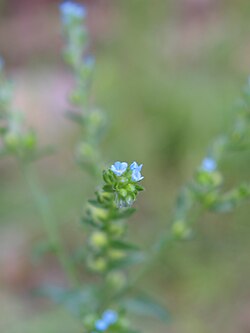| Hackelia floribunda | |
|---|---|
 | |
| Scientific classification | |
| Kingdom: | Plantae |
| Clade: | Tracheophytes |
| Clade: | Angiosperms |
| Clade: | Eudicots |
| Clade: | Asterids |
| Order: | Boraginales |
| Family: | Boraginaceae |
| Genus: | Hackelia |
| Species: | H. floribunda |
| Binomial name | |
| Hackelia floribunda | |
| Synonyms [2] | |
| |
Hackelia floribunda is a species of flowering plant, known by the common names large-flowered stickseed [3] and manyflower stickseed. [4] , in the borage family, Boraginaceae. [2] [5]
The plant is native to much of the western half of North America, in Canada and the Midwestern and Western United States.
It is most often found in areas which are wet during the springtime, such as meadows, wetlands, and riparian areas. [6]
Hackelia floribunda is a lush biennial or perennial herb with hairy stems reaching a maximum height of about 1 metre (3.3 ft). They emerge as a leafy clump, surrounded by many smooth lance-shaped leaves up to 24 centimetres (9.4 in) long.
There are few leaves at the ends of the stems, which hold cyme inflorescences of blue flowers. Each flower has five lobes with petallike appendages at their bases.
The fruit is a tiny, mildly prickly nutlet. [6]
